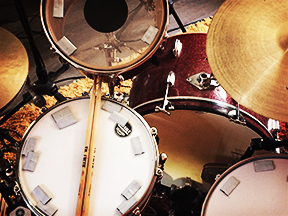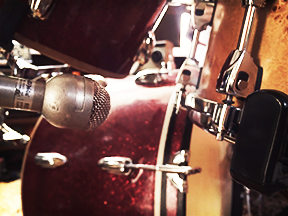I’ve always been a fan of minimal mic techniques on drums, and I still am, but the mics and their positions have changed pretty radically.
About 6 months ago, Christmas of 2016 in fact, I decided to give myself an amazing Christmas gift: I took my own advice and began to prioritize my art over my job. I resolved that, until I knew in my bones that songs were actually going to be completed, I would strip back my Kush duties, only doing what was absolutely necessary to keep the company healthy and growing, and dedicate the rest of my time to music.
The result is that the lovely Sarah & I are now 6-8 weeks away from releasing the first two tracks --- meaning music and videos (!) --- for the Sneaky Little Devil record that we have been crafting for just over two years now. And we’re in the home stretch on most of the rest of the record too, which is why I feel safe coming out of my shell, writing Museletters again, and generally pulling my head out of the sand on Facebook, Twitter, and Instagram.
Next week I’m going to share a lot more about our process for writing a genuine, full length LP record destined for vinyl, but today I’d like to discuss something near and dear to most recording engineers’ hearts: drums. Specifically, I want to share the details on how my own experimentations and explorations led me from away from the warm, dark and naturally unhyped 70’s drum tones that have always been near and dear to my heart, and into a place where I was capturing the same drums played the same way, but with very different mics, mic techniques, and processing chains, all of which resulted in a hybrid vintage-modern aesthetic that is very tightly compressed, very wide and tall, and surprisingly (for me) quite bright and forward sounding.

I’ve always been a fan of minimal mic techniques on drums, and I still am, but the mics and their positions have changed pretty radically. In the beginning, I fell in love with the venerable Coles 4038 and had a pair overhead, they have an incredible woody tone, a clear but mellow transient, and overall give a very natural picture of what the kit sounds like. I used them to fill out the space between the two close mics, a vintage and relatively rare EV RE38 dynamic on snare, and an AEA R84 ribbon on kick.
The RE38 is incredible for that old dry thud, it has an abundance of focused 100-200Hz that adds as much weight and body to a snare as you could hope for. The R84 likewise extends down to the floor, it captures all the subs in the kick and gives a very soft presentation of the slap.
Put together, those 4 mics gave me exactly the kind of hazy, intimate 70’s drum sound I’d longed for forever.
The thing is, as the record evolved, so did the amount of drama in the music. We continually refined the compositions and arrangements in ways that opened up more space in the softer parts, and filled up the spectrum with more and more intensity and density in the climactic parts, and something surprising happened: our moody and mellow songs developed psychedelically cinematic dynamics.
That in and of itself was awesome, but as we approached the completion of tracking on the 5th song we had to acknowledge a reality that we’d been avoiding for too long: my lovely 70’s drums were holding back the production, they were perfect for the mellow sections but no amount of compression and distortion could expand them enough to support the larger crests of sound happening around them.
Every artist reading this can relate to the struggle that ensued: I had crafted, practiced, then recorded incredible drum performances for 6 of the 8 songs, all of them perfect manifestations of our vision for how we wanted that part of the record to sound… and now the music was very clearly telling us that it wanted something different.
Fuck.
And still, it took another week of desperately geeking out with every analog and digital widget in my toolkit before I threw my hands up in defeat and acknowledged that a different approach to drums was required.
On that note, I then took another piece of advice I routinely give to others: I asked for help. I called Justin, a close friend and gifted engineer who recently moved to town, and asked if he’d get together and help me create a drum mic setup that’s different than anything I normally do. In an absurd bit of syncronicity, another engineer friend from the east coast (Kevin) wrote to tell me he nabbed some AT 4051a pencil condensers and thought I’d dig them, so he offered to send them my way to play with.
It needs to be said: I have some incredibly cool friends.

Anyway, the AT mics arrived while Justin and I were out snare shopping, and we found a truly magical Tama swingstar at Sam Ash before heading to my room. Knowing my playing and my tastes as he does, he says ‘let me try my jazz setup’. I only made one demand: I wanted a side-snare (aka ‘shell’) mic in play, capturing a dirty, colored sound.
We tried a few mic options overhead, including a pair of vintage Schoeps CMC5 (so wrong for this job) and Oktava mk012’s (not bad, but a bit soft and flavorless) before firing up the AT’s. To my great surprise, I’m blown away by the AT’s. They are highly colored, not in the least bit transparent. They have what is almost an excessive amount of 5k-10k, and an almost hollow midrange. And yet, the top is very smooth, and the mids have a peculiar shine. They are the polar opposite of my beloved Coles 4038’s, but equally beautiful in their own way.
The side of the snare started with a Beyer M201 (one of the best $200 you can spend on any mic) and it sounded great, but then we tried a beat up old RE10 and it had all the right kinds of grainy honky mojo. I moved it around until I find a supremely magical little spot right off a bottom lug, a spot that brought a thoroughly crusty vintage magic to the party.
The overheads captured the kit’s 1977 vibe with a distinctly modern vibe, but that side-snare mic was like a timewarp fader, the more you turned it up the older the kit sounded, slowly morphing the sound backwards from 1977 to 1967 and all points in between. Complete, utter win!
Last but not least was my favorite drum, the bass drum. I find it one of the sweetest pleasures in life to tune, play, and capture a kick sound that is apart from the herd and full of character, with growl and a distinct note and as little ‘click’ as I can get away with. A nice round ‘doomph’ is much more my style on this drum.
When Justin pulled out a Neumann M149 my eyes got wide; when he put the mic on the batter side about 1.5” from where the beater strikes the head, I felt a bead of sweat form on my brow. That’s a $5,000 mic down there!
All of these mics are going thru Omega preamps, which have 74dB of gain and reproduce every known frequency with uncanny accuracy and smoothness. Looking at the Neumann, Justin said, “You’ll need the pad for this one”. He’s right, it’s an incredibly hot mic.

I’ll cut to the chase at this point: the overall sound of those 4 mics was so utterly different than anything I’d ever captured before, and was so forward and present, it literally changed the way I played for the songs. I found myself easing up on the hi hats, which opened up even more space in the groove, which I then filled by playing more ‘toe up’ on the kick, meaning I didn’t constantly bury the beater into the head, I controlled the rebound which allows the head to resonate and ring out more fully.
And that shell-mic’d snare coming back through the headphones was so crisp and full of character I played more ghost notes with a lighter, snappier feel, adding even more drive to the grooves. Overall, I found myself playing even lighter than usual, but for the more intense and climactic parts of the song I wasn’t laying into things more, I was instead playing things in ways that rung out more, had more overtones and sustain.
When these new grooves are compressed, they sound massive, they jump out of the speakers and stretch from the floor to the ceiling. I like ‘interesting’, I love ‘vibey’, but I don’t typically reach for ‘exciting’ in my own sounds, so this was all a bit alien to me. But the muse demands what the muse demands and I’m here to serve.
To let you check out my new drum sounds for yourself, I’m finishing up a video that will show the actual mic positions and also the two mics I’ve got shoved up inside the toms.
I’ll also talk about Omega preamp gains, the settings on the Tweakers I tracked through, and the plugins used to create the sound you’re hearing… that’ll drop before the next Museletter, watch your Inbox.
Somebody somewhere once said, “If you want to be free, successful, and contented, just follow all the advice you give to others.” The more I follow that tidbit of wisdom, the better things go for me, so I’m inclined to stick with it!
Gregory Scott - ubk